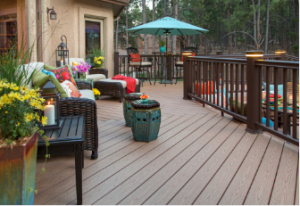Composite decking
Composite decking is a type of lumber often made of recycled materials. Its composition is similar to wood’s but more resistant to fading, cracking and other damage. Composites also have fewer maintenance requirements than wood. Unlike wood, composite decking requires little or no staining and is not susceptible to termites.
Manufacturers make composite decking using various moulds. These moulds allow for different textures and colours. Textures range from smooth to almost varnished, and there are straight and circular grains that have a realistic look. Many manufacturers offer matching paint or stains. However, some manufacturers are less environmentally friendly than others. Learn more info here www.superbpergolasndecks.com.au/decking-adelaide.
 The most common types of composite decking are made from recycled plastic. Polypropylene-based composites are more robust and heavier than other types. However, they also contain some wood. If you are concerned about the environmental impact of this type of material, choose one with a synthetic core. An artificial cap increases the strength of the decking and makes it resistant to staining and discolouration.
The most common types of composite decking are made from recycled plastic. Polypropylene-based composites are more robust and heavier than other types. However, they also contain some wood. If you are concerned about the environmental impact of this type of material, choose one with a synthetic core. An artificial cap increases the strength of the decking and makes it resistant to staining and discolouration.
There are three types of composite decking: solid composites, hollow composites, and synthetic composites. Each class is more or less durable, but not all are equally dependable. Most composite decking boards are made of recycled materials and wood fibre. Hollow composites are lighter and have a more artificial appearance than solid composites. On the other hand, concrete composites are much heavier and can warp under extreme weather conditions.
For some homeowners, natural wood might be preferable to composites. But these decks are more expensive than composites, and the wood may rot over time. Additionally, if the deck is humid, you may have to clean it more frequently. In addition, some composites can’t be sanded. Despite these disadvantages, most composites are highly resistant to moisture.
The latest generation of composite decking is more durable and fade-resistant. These new technologies also provide more options for homeowners. For example, using an edge fastener, such as hidden fasteners, will make the installation of composite decking faster. Hidden fasteners clip into grooves in adjacent rows of deck boards, removing the need for spacers.
Composite decking is installed perpendicular to joists or diagonally 12″ on the centre. It makes it possible to have an enormous variety of shapes and sizes. While many composites come in 12′, 16′, and 20′ lengths, you can buy boards with custom widths and lengths. Installing a circular saw is an option as well. Depending on the manufacturer, composite decking boards can be installed with screws through the face or with face fasteners.
Wood decking
If you’re building a deck, there are plenty of different options. There’s pressure-treated lumber, composites, and natural wood. It’s up to you to decide which material is best for your particular needs and budget. Wood and composites may be the most attractive options, but you must also consider how much maintenance you’ll need to do to keep your new deck looking great.
The best wood for your deck is a good fit for the environment. It should be eco-friendly, and it should be easy to work with. Also, you should avoid wood that is treated with toxic chemicals. For example, a lot of pressure-treated lumber is made from Southern yellow pine. This type of wood is prone to rot, so you’ll need to stain and re-seal your deck regularly to keep it from getting mouldy.
Two main types of wood used in decking are softwood and hardwood. Both types of wood are durable, but each has pros and cons. Softwoods are cheaper, but they’re a bit more susceptible to decay and can easily warp. They are also a popular food source for termites.
Hardwoods are usually more expensive but more resistant to rot and insect infestation. A hardwood deck can last for decades. And they’re generally more complex than softwoods, making them more challenging to drill and cut. However, if you want a sturdy deck that is easy to clean and maintain, hardwood is your best bet. Learn more info here www.superbpergolasndecks.com.au/decking-adelaide.
Pressure-treated lumber is a traditional low-cost deck board. It’s easy to find and relatively cheap, requiring little maintenance. However, you should re-stain and re-seal your boards every couple of years, and you’ll need to pressure wash them from time to time. As with any other material, it’s best to wear protective clothing when handling pressure-treated material. Some people also prefer to use a mask when taking pressure-treated lumber, as the chemicals can be highly corrosive.
Composites, on the other hand, are made to look like natural wood. The material combines plastic and waste wood fibres into a material that mimics the look of wood. These composites are available in various colours and styles, and they’re usually made to look like natural wood. But a composite deck will typically cost more than a wooden one, and they are more susceptible to mildew. Additionally, natural wood may be stiffer than composites. Furthermore, they can become uncomfortably warm in direct sunlight.
To compare pressure-treated wood with composites, you’ll need to look at how the two materials perform in the real world. Both products can last decades but require more care and attention than their synthetic counterparts. For example, while a composite doesn’t need to be stained, it does require regular brushing to remove mould and mildew.
Wood has long been the most affordable option for decking. However, in recent years, synthetic materials have increased availability. Learn more info here www.superbpergolasndecks.com.au/decking-adelaide.